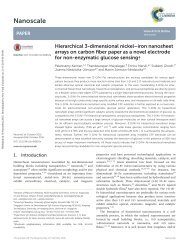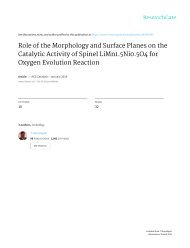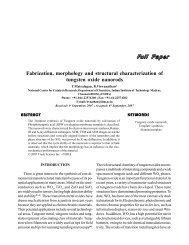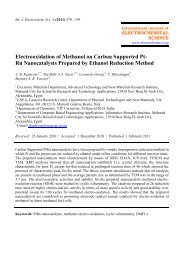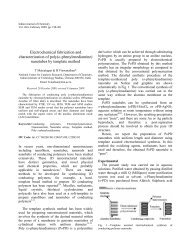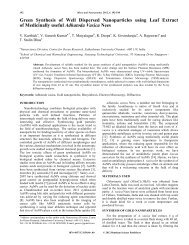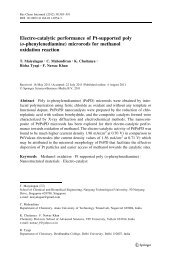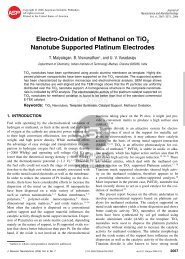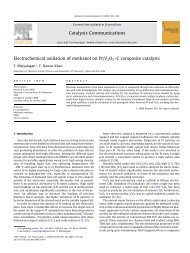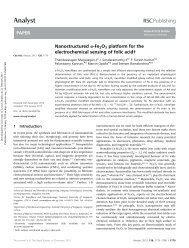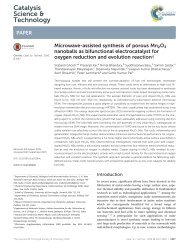The Effects of Cathode Parameters on the Performance of Poly(2,5-Benzimidazole)-Based Polymer Electrolyte Membrane Fuel Cell
The Effects of Cathode Parameters on the Performance of Poly(2,5-Benzimidazole)-Based Polymer Electrolyte Membrane Fuel Cell
The Effects of Cathode Parameters on the Performance of Poly(2,5-Benzimidazole)-Based Polymer Electrolyte Membrane Fuel Cell
Create successful ePaper yourself
Turn your PDF publications into a flip-book with our unique Google optimized e-Paper software.
Electrocatalysis<br />
DOI 10.1007/s12678-014-0228-8<br />
<str<strong>on</strong>g>The</str<strong>on</strong>g> <str<strong>on</strong>g>Effects</str<strong>on</strong>g> <str<strong>on</strong>g>of</str<strong>on</strong>g> <str<strong>on</strong>g>Cathode</str<strong>on</strong>g> <str<strong>on</strong>g>Parameters</str<strong>on</strong>g> <strong>on</strong> <strong>the</strong> <strong>Performance</strong><br />
<str<strong>on</strong>g>of</str<strong>on</strong>g> <strong>Poly</strong>(2,5-<strong>Benzimidazole</strong>)-<strong>Based</strong> <strong>Poly</strong>mer <strong>Electrolyte</strong> <strong>Membrane</strong><br />
<strong>Fuel</strong> <strong>Cell</strong><br />
T Maiyalagan & SPasupathi& B G Pollet<br />
# Springer Science+Business Media New York 2014<br />
Abstract <str<strong>on</strong>g>The</str<strong>on</strong>g> effects <str<strong>on</strong>g>of</str<strong>on</strong>g> electrode parameters <strong>on</strong> membrane<br />
electrode assembly performance including Pt loading, hydrophobicity<br />
during heat treatment, catalyst layer thickness and<br />
<strong>the</strong> amount <str<strong>on</strong>g>of</str<strong>on</strong>g> polytetrafluoroethylene (PTFE) in <strong>the</strong> cathode<br />
are investigated. <str<strong>on</strong>g>The</str<strong>on</strong>g> fuel cell performance is maximized via<br />
catalyst utilizati<strong>on</strong> by optimizing <strong>the</strong> phosphoric acid c<strong>on</strong>tent<br />
in <strong>the</strong> electrodes. Heat treatment <str<strong>on</strong>g>of</str<strong>on</strong>g> gas diffusi<strong>on</strong> electrode<br />
results in an increase in hydrophobicity and a decrease in<br />
phosphoric acid c<strong>on</strong>tent in <strong>the</strong> catalyst layer, which drastically<br />
affects <strong>the</strong> fuel cell performance. In our c<strong>on</strong>diti<strong>on</strong>s, a maximum<br />
fuel cell performance <str<strong>on</strong>g>of</str<strong>on</strong>g> 270 mW cm −2 was achieved at<br />
160 °C with air using 1 mg Pt cm −2 total catalyst loading<br />
(20 % PTFE). <str<strong>on</strong>g>The</str<strong>on</strong>g> fuel cell performance and <strong>the</strong> pois<strong>on</strong>ing<br />
effect <str<strong>on</strong>g>of</str<strong>on</strong>g> carb<strong>on</strong> m<strong>on</strong>oxide in poly(2,5-benzimidazole)<br />
(ABPBI)-membrane-based high-temperature membrane electrode<br />
assemblies were investigated with respect to carb<strong>on</strong><br />
m<strong>on</strong>oxide c<strong>on</strong>centrati<strong>on</strong>s. <strong>Fuel</strong> cell performance <str<strong>on</strong>g>of</str<strong>on</strong>g> Pt alloys<br />
(Pt-Cu/C, Pt-Fe/C, Pt-Ni/C) is compared with that <str<strong>on</strong>g>of</str<strong>on</strong>g> Pt/C at<br />
temperatures between 140 and 180 °C. It was observed that<br />
Pt-Cu/C alloy catalysts exhibit higher performance with lower<br />
catalyst loadings (0.4 mg Pt cm −2 ) than Pt/C catalyst. <str<strong>on</strong>g>The</str<strong>on</strong>g><br />
performance <str<strong>on</strong>g>of</str<strong>on</strong>g> alloy catalysts follows <strong>the</strong> order <str<strong>on</strong>g>of</str<strong>on</strong>g> Pt-Cu/C><br />
Pt-Fe/C>Pt-Ni/C>Pt/C.<br />
Keywords Gas diffusi<strong>on</strong> electrode . HT-PEMFCs . ABPBI .<br />
Phosphoric acid . <strong>Membrane</strong> electrode assembly . Pt alloy<br />
catalysts . Electrode performance<br />
T. Maiyalagan (*): S. Pasupathi : B. G. Pollet<br />
HySA Systems Competence Centre, South African Institute for<br />
Advanced Materials Chemistry, University <str<strong>on</strong>g>of</str<strong>on</strong>g> <strong>the</strong> Western Cape,<br />
Modderdam Road, Bellville, Cape Town 7535, South Africa<br />
e-mail: maiyalagan@gmail.com<br />
Introducti<strong>on</strong><br />
<str<strong>on</strong>g>The</str<strong>on</strong>g> progress <str<strong>on</strong>g>of</str<strong>on</strong>g> high-temperature polymer electrolyte membrane<br />
fuel cells (HT-PEMFCs) in recent years attracted increased<br />
attenti<strong>on</strong> as an alternative to c<strong>on</strong>venti<strong>on</strong>al lowtemperature<br />
PEM fuel cells [1]. Nafi<strong>on</strong>® is <strong>the</strong> accepted<br />
current bench mark perfluorosulph<strong>on</strong>ic acid polymer membrane<br />
used in low-temperature fuel cells [2]. <str<strong>on</strong>g>The</str<strong>on</strong>g> lack <str<strong>on</strong>g>of</str<strong>on</strong>g> mass<br />
commercializati<strong>on</strong> <str<strong>on</strong>g>of</str<strong>on</strong>g> low-temperature PEM fuel cell is due to<br />
limited operati<strong>on</strong> temperature (
Electrocatalysis<br />
based <strong>on</strong> PBI/ABPBI/o<strong>the</strong>r membranes saturated with phosphoric<br />
acid became commercially available under different<br />
trade name such as Celtec (BASF) and Advent [12, 13].<br />
<str<strong>on</strong>g>The</str<strong>on</strong>g> gas diffusi<strong>on</strong> electrodes (GDE) form an integral part <str<strong>on</strong>g>of</str<strong>on</strong>g><br />
<strong>the</strong> membrane electrode assembly, c<strong>on</strong>sist <str<strong>on</strong>g>of</str<strong>on</strong>g> gas diffusi<strong>on</strong><br />
layer (GDL) and catalyst layer each performing a specific<br />
functi<strong>on</strong>. <str<strong>on</strong>g>The</str<strong>on</strong>g> GDL is preferably a carb<strong>on</strong> paper or a carb<strong>on</strong><br />
cloth <str<strong>on</strong>g>of</str<strong>on</strong>g>fering a supporting structure for <strong>the</strong> catalyst layer and<br />
also acting as a passage for fuel and oxygen gas to <strong>the</strong> catalyst.<br />
Great interest has been paid in <strong>the</strong> past, and excellent reviews<br />
have been published <strong>on</strong> gas diffusi<strong>on</strong> electrodes for lowtemperature<br />
fuel cells [14]. <strong>Poly</strong>tetrafluoroethylene (PTFE)<br />
binder is highly hydrophobic, and <strong>the</strong> usage <str<strong>on</strong>g>of</str<strong>on</strong>g> PTFE binder<br />
in gas diffusi<strong>on</strong> electrode increases <strong>the</strong> porous structure in <strong>the</strong><br />
catalyst layer and increases mass transport <str<strong>on</strong>g>of</str<strong>on</strong>g> <strong>the</strong> reactants.<br />
<str<strong>on</strong>g>The</str<strong>on</strong>g> influence <str<strong>on</strong>g>of</str<strong>on</strong>g> different types <str<strong>on</strong>g>of</str<strong>on</strong>g> GDE and <strong>the</strong> amount <str<strong>on</strong>g>of</str<strong>on</strong>g><br />
PTFE used <strong>on</strong> fuel cell performances have been well studied<br />
[15]. Lobato et al. [16] studied <strong>the</strong> effect <str<strong>on</strong>g>of</str<strong>on</strong>g> PTFE loading in<br />
<strong>the</strong> GDL <strong>on</strong> PBI-based PEM fuel cell. To maximize <strong>the</strong><br />
performance and stability <str<strong>on</strong>g>of</str<strong>on</strong>g> ABPBI MEAs, it is necessary<br />
to maintain <strong>the</strong> phosphoric acid distributi<strong>on</strong> between <strong>the</strong><br />
membranes, <strong>the</strong> catalyst layers and <strong>the</strong> gas diffusi<strong>on</strong> layers.<br />
Wannek et al. [17] reported <strong>the</strong> relati<strong>on</strong> between <strong>the</strong> phosphoric<br />
acid c<strong>on</strong>tent in <strong>the</strong> catalyst layer and fuel cell performance.<br />
<str<strong>on</strong>g>The</str<strong>on</strong>g> fuel cell performances <str<strong>on</strong>g>of</str<strong>on</strong>g> <strong>the</strong> ABPBI MEAs depend <strong>on</strong><br />
many electrode parameters: (1) type <str<strong>on</strong>g>of</str<strong>on</strong>g> gas diffusi<strong>on</strong> layer and<br />
its characteristics (porosity and thickness), (2) PTFE amount,<br />
(3) phosphoric acid amount, (4) heat treatment <str<strong>on</strong>g>of</str<strong>on</strong>g> gas diffusi<strong>on</strong><br />
electrode, (5) thickness <str<strong>on</strong>g>of</str<strong>on</strong>g> catalyst layers and (6) nature <str<strong>on</strong>g>of</str<strong>on</strong>g><br />
electrocatalyst (Pt and Pt alloys, Pt loading, Pt particles size,<br />
type <str<strong>on</strong>g>of</str<strong>on</strong>g> carb<strong>on</strong> as <strong>the</strong> support).<br />
<str<strong>on</strong>g>The</str<strong>on</strong>g>re are a lot <str<strong>on</strong>g>of</str<strong>on</strong>g> scientific efforts that are under way to<br />
reduce Pt loading and improve <strong>the</strong> catalytic activity <str<strong>on</strong>g>of</str<strong>on</strong>g> <strong>the</strong><br />
cathode. Pt alloy catalysts, including Pt-Co, Pt-Ni and PTFE<br />
exhibit higher ORR activity than Pt/C, have been thoroughly<br />
investigated for low-temperature PEM fuel cells. Although Pt<br />
alloys exhibit higher ORR activity, <strong>the</strong>re are no much studies<br />
<strong>on</strong> <strong>the</strong> performance <str<strong>on</strong>g>of</str<strong>on</strong>g> Pt alloys in ABPBI-based high-temperature<br />
fuel cells. Also, <strong>the</strong>re is <strong>the</strong> possibility <str<strong>on</strong>g>of</str<strong>on</strong>g> dissoluti<strong>on</strong><br />
<str<strong>on</strong>g>of</str<strong>on</strong>g> metal in <strong>the</strong> phosphoric envir<strong>on</strong>ment. Thus, high performance<br />
and reducti<strong>on</strong> in Pt loading <str<strong>on</strong>g>of</str<strong>on</strong>g> ABPBI MEAs can be<br />
achieved using suitable alloy catalyts.<br />
<str<strong>on</strong>g>The</str<strong>on</strong>g> purpose <str<strong>on</strong>g>of</str<strong>on</strong>g> <strong>the</strong> present study is to identify proper active<br />
Pt alloy catalysts with reduced precious loading that lead to<br />
improved ORR activity and anode catalyst activity for <strong>the</strong><br />
oxidati<strong>on</strong> <str<strong>on</strong>g>of</str<strong>on</strong>g> CO in <strong>the</strong> presence <str<strong>on</strong>g>of</str<strong>on</strong>g> hydrogen in ABPBIbased<br />
high-temperature fuel cells. One <str<strong>on</strong>g>of</str<strong>on</strong>g> <strong>the</strong> appealing<br />
greatest advantages <str<strong>on</strong>g>of</str<strong>on</strong>g> high-temperature PEM fuel cells is<br />
<strong>the</strong> tolerance <str<strong>on</strong>g>of</str<strong>on</strong>g> anodes for <strong>the</strong> oxidati<strong>on</strong> <str<strong>on</strong>g>of</str<strong>on</strong>g> CO in <strong>the</strong> presence<br />
<str<strong>on</strong>g>of</str<strong>on</strong>g> hydrogen. Additi<strong>on</strong>ally, <strong>the</strong> commercializati<strong>on</strong> <str<strong>on</strong>g>of</str<strong>on</strong>g> MEAs<br />
and fuel cells made <strong>the</strong>re<str<strong>on</strong>g>of</str<strong>on</strong>g>, using <strong>the</strong> new membrane materials<br />
and optimized electrode structure <str<strong>on</strong>g>of</str<strong>on</strong>g> high-performance<br />
fuel cells for commercializati<strong>on</strong>, still requires c<strong>on</strong>siderable<br />
research and development efforts. <str<strong>on</strong>g>The</str<strong>on</strong>g> aim <str<strong>on</strong>g>of</str<strong>on</strong>g> this study is to<br />
improve <strong>the</strong> performance and reduce <strong>the</strong> loading <str<strong>on</strong>g>of</str<strong>on</strong>g> ABPBIbased<br />
MEAs by optimizing <strong>the</strong> electrode parameters. <str<strong>on</strong>g>The</str<strong>on</strong>g><br />
fabricated MEAs were tested in laboratory scale<br />
25 cm 2 cells at 160 °C to evaluate <strong>the</strong> most promising MEA<br />
formulati<strong>on</strong>. <str<strong>on</strong>g>The</str<strong>on</strong>g> catalyst and electrode structure in <strong>the</strong> MEAs<br />
play a major role in determining fuel cell performance. This<br />
paper explores <strong>the</strong> effects <str<strong>on</strong>g>of</str<strong>on</strong>g> electrode parameters such as Pt<br />
loading, catalyst thickness, PTFE c<strong>on</strong>tent and carb<strong>on</strong> supports<br />
<strong>on</strong> <strong>the</strong> performance <str<strong>on</strong>g>of</str<strong>on</strong>g> <strong>the</strong> cathode for ABPBI-based HT-<br />
PEMFC. Besides, <strong>the</strong> electrochemical performance in <strong>the</strong><br />
presence <str<strong>on</strong>g>of</str<strong>on</strong>g> various c<strong>on</strong>centrati<strong>on</strong>s <str<strong>on</strong>g>of</str<strong>on</strong>g> carb<strong>on</strong> m<strong>on</strong>oxide is<br />
discussed.<br />
Experimental Procedures<br />
Physiochemical Characterizati<strong>on</strong> <str<strong>on</strong>g>of</str<strong>on</strong>g> <strong>the</strong> Catalysts<br />
<str<strong>on</strong>g>The</str<strong>on</strong>g> commercial catalysts used in <strong>the</strong> MEAs were analyzed by<br />
<strong>the</strong> X-ray diffracti<strong>on</strong> (XRD) technique, which was recorded in<br />
<strong>the</strong> range <str<strong>on</strong>g>of</str<strong>on</strong>g> 10–80° with a scan step width <str<strong>on</strong>g>of</str<strong>on</strong>g> 0.02 and a<br />
counting time <str<strong>on</strong>g>of</str<strong>on</strong>g> 1 s per step using Bruker D2 X-ray diffractometer<br />
with Cu K α radiati<strong>on</strong> (λ=1.5418 Å). Nitrogen<br />
adsorpti<strong>on</strong>-desorpti<strong>on</strong> iso<strong>the</strong>rms <str<strong>on</strong>g>of</str<strong>on</strong>g> <strong>the</strong> catalysts samples were<br />
obtained using a Micromeritics ASAP 2020 sorptometer. <str<strong>on</strong>g>The</str<strong>on</strong>g><br />
total surface area and pore volume were calculated using <strong>the</strong><br />
Brunauer-Emmett-Teller (BET) and <strong>the</strong> multi-point method.<br />
MEA Preparati<strong>on</strong><br />
<str<strong>on</strong>g>The</str<strong>on</strong>g> ABPBI membranes were purchased from FuMA-Tech in<br />
an acid-free form. <str<strong>on</strong>g>The</str<strong>on</strong>g> dry ABPBI membranes (previously cut<br />
into 7×7 cm) were immersed in phosphoric acid soluti<strong>on</strong>s<br />
(85 %) and <strong>the</strong>n heated at 120 °C for 12 h for effective doping<br />
<str<strong>on</strong>g>of</str<strong>on</strong>g> phosphoric acid across <strong>the</strong> polymer. <str<strong>on</strong>g>The</str<strong>on</strong>g> excess phosphoric<br />
acid was removed from <strong>the</strong> ABPBI membrane.<br />
<str<strong>on</strong>g>The</str<strong>on</strong>g> prot<strong>on</strong>ic c<strong>on</strong>ductivity <str<strong>on</strong>g>of</str<strong>on</strong>g> ABPBI membrane without a<br />
dopant is negligible and phosphoric acid has <strong>the</strong> highest<br />
intrinsic prot<strong>on</strong> c<strong>on</strong>ducti<strong>on</strong> am<strong>on</strong>g <strong>the</strong> substances known.<br />
Higher doping <str<strong>on</strong>g>of</str<strong>on</strong>g> phosphoric acid in ABPBI membranes<br />
facilitates higher prot<strong>on</strong> c<strong>on</strong>ducti<strong>on</strong>. However, <strong>the</strong> mechanical<br />
stability deteriorates and ABPBI membranes disintegrate <strong>on</strong><br />
increasing <strong>the</strong> doping level <str<strong>on</strong>g>of</str<strong>on</strong>g> phosphoric acid at higher temperatures.<br />
In our study, <strong>the</strong> ABPBI membrane was treated in<br />
85 % (or 14.8 M) phosphoric acid at 120 °C for 12 h. <str<strong>on</strong>g>The</str<strong>on</strong>g><br />
treated membrane c<strong>on</strong>tained 3.1 molecules <str<strong>on</strong>g>of</str<strong>on</strong>g> phosphoric acid<br />
per repeat unit [18]. <str<strong>on</strong>g>The</str<strong>on</strong>g> specific c<strong>on</strong>ductivity for ABPBI×3.1<br />
H 3 PO 4 at 140 °C has found to be 74 mS cm −1 [17, 18].<br />
<str<strong>on</strong>g>The</str<strong>on</strong>g> phosphoric acid doped ABPBI membrane samples<br />
were placed in-between catalyzed GDEs to form <strong>the</strong> MEAs.<br />
Catalyst inks were coated <strong>on</strong> <strong>the</strong> commercial gas diffusi<strong>on</strong><br />
layer (GDL, carb<strong>on</strong> paper) (H2315 CX196) obtained from
Electrocatalysis<br />
Freudenberg FCCT, Germany. Catalyst inks were prepared<br />
with mixture <str<strong>on</strong>g>of</str<strong>on</strong>g> appropriate amount <str<strong>on</strong>g>of</str<strong>on</strong>g> platinum loading <str<strong>on</strong>g>of</str<strong>on</strong>g> 20<br />
to 60 wt% (JM HiSPEC 4000, from Johns<strong>on</strong> Mat<strong>the</strong>y) and<br />
aqueous dispersi<strong>on</strong>s <str<strong>on</strong>g>of</str<strong>on</strong>g> PTFE (Dyne<strong>on</strong>) were prepared by<br />
ultras<strong>on</strong>ic (40 kHz) agitati<strong>on</strong> for 20–40 min in a mixture <str<strong>on</strong>g>of</str<strong>on</strong>g><br />
water and isopropanol. <str<strong>on</strong>g>The</str<strong>on</strong>g> catalyst ink was highly dispersed<br />
by an ultras<strong>on</strong>ic homogenizer several times for 30 s each. This<br />
catalyst ink was agitated until it turned into good dispersi<strong>on</strong>.<br />
<str<strong>on</strong>g>The</str<strong>on</strong>g>se inks were uniformly sprayed <strong>on</strong> <strong>the</strong> microporous layer<br />
<str<strong>on</strong>g>of</str<strong>on</strong>g> a commercially available GDL (Freudenberg FCCT) by a<br />
spraying technique followed by an air drying step. <str<strong>on</strong>g>The</str<strong>on</strong>g> GDE<br />
were produced with c<strong>on</strong>trolled platinum loadings ranging<br />
between 0.5 and 2.0 mg Pt cm −2 . <str<strong>on</strong>g>The</str<strong>on</strong>g> catalyst layers were<br />
impregnated with appropriate amounts <str<strong>on</strong>g>of</str<strong>on</strong>g> phosphoric acid to<br />
<strong>the</strong> surface <str<strong>on</strong>g>of</str<strong>on</strong>g> <strong>the</strong> GDEs and were left overnight for uniform<br />
distributi<strong>on</strong>. <str<strong>on</strong>g>The</str<strong>on</strong>g> phosphoric acid impregnated gas diffusi<strong>on</strong><br />
electrode is <strong>the</strong>n combined with phosphoric acid doped<br />
ABPBI membranes to form an MEA.<br />
Single <strong>Fuel</strong> <strong>Cell</strong> Tests<br />
<str<strong>on</strong>g>The</str<strong>on</strong>g> fuel cell tests for evaluating <strong>the</strong> HT-PEMFC were c<strong>on</strong>ducted<br />
in 25-cm 2 single cell setups using graphite flow field<br />
plates. Commercial Freudenberg gaskets made <str<strong>on</strong>g>of</str<strong>on</strong>g> fluorinated<br />
polymer with thickness <str<strong>on</strong>g>of</str<strong>on</strong>g> 50 μm were used as sealants. <str<strong>on</strong>g>The</str<strong>on</strong>g><br />
cell was assembled in a cell compressi<strong>on</strong> unit from Pragma<br />
Industries for uniform pressure <strong>on</strong> <strong>the</strong> MEA. <str<strong>on</strong>g>The</str<strong>on</strong>g> MEAs were<br />
fabricated with phosphoric acid with doped ABPBI membrane<br />
sandwiched GDEs into <strong>the</strong> test cells without hot pressing.<br />
<str<strong>on</strong>g>The</str<strong>on</strong>g> prepared MEAs were assembled in <strong>the</strong> cell compressi<strong>on</strong><br />
unit (CCU) which operated, at c<strong>on</strong>stant force, with high<br />
accuracy and was able to precisely measure <strong>the</strong> influence <str<strong>on</strong>g>of</str<strong>on</strong>g><br />
compressi<strong>on</strong> over <strong>the</strong> MEA and <strong>the</strong> GDL. A compressi<strong>on</strong><br />
force <str<strong>on</strong>g>of</str<strong>on</strong>g> 1.5 N/mm 2 was applied throughout all <strong>the</strong> experiments.<br />
<str<strong>on</strong>g>The</str<strong>on</strong>g> performance <str<strong>on</strong>g>of</str<strong>on</strong>g> <strong>the</strong> MEAs was analyzed after<br />
c<strong>on</strong>diti<strong>on</strong>ing for 24 h at +0.6 V where <strong>the</strong> cell is operated at<br />
160 °C, with <strong>the</strong> air and hydrogen using an in-house built up<br />
fuel cell test system. <str<strong>on</strong>g>The</str<strong>on</strong>g> fuel cell test system c<strong>on</strong>sists <str<strong>on</strong>g>of</str<strong>on</strong>g><br />
c<strong>on</strong>trol <str<strong>on</strong>g>of</str<strong>on</strong>g> <strong>the</strong> electr<strong>on</strong>ic load Hocherl & Hackl GmBH load<br />
and <strong>the</strong> mass flow c<strong>on</strong>trollers with lab view. Unless o<strong>the</strong>rwise<br />
noted, <strong>the</strong> cells are operated at 160 °C in ambient pressure<br />
using hydrogen and air with stoichiometries <str<strong>on</strong>g>of</str<strong>on</strong>g> 0.6 and 1.8,<br />
respectively.<br />
Results and Discussi<strong>on</strong><br />
Physicochemical Characterizati<strong>on</strong> <str<strong>on</strong>g>of</str<strong>on</strong>g> Electrocatalysts<br />
<str<strong>on</strong>g>The</str<strong>on</strong>g> catalysts surface areas were studied by nitrogen<br />
physisorpti<strong>on</strong> method that are shown in Figure 1 and <strong>the</strong><br />
results are summarized in Table 1. <str<strong>on</strong>g>The</str<strong>on</strong>g> data shows that BET<br />
Fig 1 Nitrogen physisorpti<strong>on</strong> iso<strong>the</strong>rms <str<strong>on</strong>g>of</str<strong>on</strong>g> (a) 20 % Pt/C, (b) 40 % Pt/C,<br />
(c) 60 % Pt/C and (d) 60 % Pt/HSAC catalysts<br />
surface areas <str<strong>on</strong>g>of</str<strong>on</strong>g> <strong>the</strong> catalysts tend to decrease with increase in<br />
metal loading <strong>on</strong> <strong>the</strong> carb<strong>on</strong> support. [19] <str<strong>on</strong>g>The</str<strong>on</strong>g> catalyst 60 %<br />
Pt/C has a lower surface area and total pore volume than <strong>the</strong><br />
40 % Pt/C and 20 % Pt/C. <str<strong>on</strong>g>The</str<strong>on</strong>g> 60 % Pt/high surface area<br />
carb<strong>on</strong> (HSAC) has higher surface area compared to 20, 40<br />
and 60 % Pt/C due to replacement <str<strong>on</strong>g>of</str<strong>on</strong>g> c<strong>on</strong>venti<strong>on</strong>al Vulcan<br />
carb<strong>on</strong> by high surface area carb<strong>on</strong> catalyst support. <str<strong>on</strong>g>The</str<strong>on</strong>g><br />
average Pt particle size <str<strong>on</strong>g>of</str<strong>on</strong>g> 60 % Pt/HSAC catalyst is 3.5 nm<br />
which is smaller than those for o<strong>the</strong>r commercial 60 % Pt/C<br />
catalysts. It was also inferred that metal dispersi<strong>on</strong> is increased<br />
by high surface area carb<strong>on</strong> support.<br />
<str<strong>on</strong>g>The</str<strong>on</strong>g> BET surface area, total pore volume, micropore<br />
volume and pore size distributi<strong>on</strong> <str<strong>on</strong>g>of</str<strong>on</strong>g> Pt/C catalysts vary<br />
with Pt loading as shown in Table 1. Pore size distributi<strong>on</strong><br />
data were calculated by <strong>the</strong> Barrett-Joyner-Halenda (BJH)<br />
from <strong>the</strong> adsorpti<strong>on</strong> and desorpti<strong>on</strong> branches. <str<strong>on</strong>g>The</str<strong>on</strong>g> BJH pore<br />
size distributi<strong>on</strong> for <strong>the</strong> commercial electrocatalysts is<br />
shown in Figure 2. <str<strong>on</strong>g>The</str<strong>on</strong>g> catalysts with lower metal loading<br />
(20 % Pt/C) have usually larger total pore volumes due to<br />
higher proporti<strong>on</strong> <str<strong>on</strong>g>of</str<strong>on</strong>g> micropores <strong>on</strong> <strong>the</strong> catalysts. In particular,<br />
<strong>the</strong> decrease <str<strong>on</strong>g>of</str<strong>on</strong>g> <strong>the</strong> micropore volume and micropore<br />
area was more significant with increasing catalyst loading<br />
<strong>on</strong> <strong>the</strong> carb<strong>on</strong> supports. Sixty percent Pt/HSAC has higher<br />
c<strong>on</strong>tent <str<strong>on</strong>g>of</str<strong>on</strong>g> micro-porosity than 20, 40 and 60 % Pt/C catalysts<br />
which str<strong>on</strong>gly indicate thatPtwasmainlydistributed<br />
throughout <strong>the</strong> microporous structure. <str<strong>on</strong>g>The</str<strong>on</strong>g> XRD patterns<br />
for all commercial catalysts are shown in Figure 3. <str<strong>on</strong>g>The</str<strong>on</strong>g><br />
characteristic diffracti<strong>on</strong> peaks <str<strong>on</strong>g>of</str<strong>on</strong>g> <strong>the</strong> face-centred cubic<br />
structure are clearly detected in all <strong>the</strong> catalyst. However,<br />
<strong>the</strong> intensity and width <str<strong>on</strong>g>of</str<strong>on</strong>g> <strong>the</strong> peaks, which are related with<br />
<strong>the</strong> Pt crystallite size, depend up<strong>on</strong> <strong>the</strong> carb<strong>on</strong> material used<br />
as support. Pt crystallite sizes obtained from <strong>the</strong> 220 peak in<br />
<strong>the</strong> XRD diffractograms (shown in Figure 3) using<strong>the</strong><br />
Scherrer equati<strong>on</strong> are shown in Table 1. It can be clearly<br />
seen that <strong>the</strong> higher <strong>the</strong> platinum percentage in <strong>the</strong> catalysts,<br />
<strong>the</strong> larger <strong>the</strong> platinum particle size resulting in lower<br />
platinum surface area [19].
Electrocatalysis<br />
Table 1 <str<strong>on</strong>g>The</str<strong>on</strong>g> results <str<strong>on</strong>g>of</str<strong>on</strong>g> N 2 physisorpti<strong>on</strong> <strong>on</strong> various Pt/C catalysts with same Pt loading (1 mg Pt cm −2 ) and 40 % PTFE used in this work<br />
Catalysts<br />
Particle<br />
size a<br />
(nm)<br />
BET surface<br />
area<br />
(m 2 g −1 )<br />
Total pore<br />
volume<br />
(cm 3 g −1 )<br />
Micropore<br />
area<br />
(m 2 g −1 )<br />
Micropore<br />
volume<br />
(cm 3 g −1 )<br />
Current density b<br />
(mA cm −2 ) at cell<br />
voltage <str<strong>on</strong>g>of</str<strong>on</strong>g> 0.3 V<br />
20 % Pt/C (JM HiSPEC 3000) 2.8 184 0.822 42.39 0.018 700<br />
40 % Pt/C (JM HiSPEC 4000) 3.59 141 0.65 32.34 0.014 945<br />
60 % Pt/C (JM HiSPEC 9000) 5.4 101 0.704 32.0 0.011 1061<br />
60 % Pt/HSAC (JM HiSPEC 9100) 3.5 321 1.229 63.4 0.031 677<br />
a Estimated from XRD<br />
b Current density <str<strong>on</strong>g>of</str<strong>on</strong>g> HT-PEMFC single cells measured at +0.3 V and 160 °C<br />
Electrode <strong>Performance</strong> with Variable PTFE C<strong>on</strong>tent<br />
<str<strong>on</strong>g>The</str<strong>on</strong>g> influence <str<strong>on</strong>g>of</str<strong>on</strong>g> polytetrafluoroethylene (PTFE) c<strong>on</strong>tent<br />
used <strong>on</strong> fuel cell performances has been previously studied<br />
[20, 21]. <str<strong>on</strong>g>The</str<strong>on</strong>g> anode and cathode c<strong>on</strong>sisted <str<strong>on</strong>g>of</str<strong>on</strong>g> 40 wt% Pt/C<br />
(1.0 mg Pt cm −2 ) electrocatalysts and <strong>the</strong> electrode parameters<br />
<str<strong>on</strong>g>of</str<strong>on</strong>g> <strong>the</strong> anode were fixed. PTFE c<strong>on</strong>tent in <strong>the</strong> fuel cell<br />
catalyst layer plays a major role in <strong>the</strong> performance <str<strong>on</strong>g>of</str<strong>on</strong>g> HT-<br />
PEMFCs. <str<strong>on</strong>g>The</str<strong>on</strong>g> amount <str<strong>on</strong>g>of</str<strong>on</strong>g> phosphoric acid in <strong>the</strong> GDE was<br />
kept c<strong>on</strong>stant (20 mg cm −2 ) for <strong>the</strong> anode and cathode.<br />
Typically, 20–60 wt% PTFE is added to <strong>the</strong> cathode catalyst<br />
layer in phosphoric acid doped ABPBI membrane fuel<br />
cells. Heat treatment <str<strong>on</strong>g>of</str<strong>on</strong>g> PTFE increases <strong>the</strong> pore volume <str<strong>on</strong>g>of</str<strong>on</strong>g><br />
<strong>the</strong> porous structure and facilitates mass transport <str<strong>on</strong>g>of</str<strong>on</strong>g> <strong>the</strong><br />
reactants [20, 21]. However, excess PTFE forms a thick<br />
catalyst layer that will lead to increased resistance. <str<strong>on</strong>g>The</str<strong>on</strong>g> fuel<br />
cell performance at 160 °C with varying PTFE c<strong>on</strong>tents in<br />
cathode catalyst layer is shown in Figure 4. <str<strong>on</strong>g>The</str<strong>on</strong>g>PTFE<br />
c<strong>on</strong>tent in <strong>the</strong> cathode catalyst layer was varied up to<br />
60 wt%. A clear trend that increasing <strong>the</strong> PTFE c<strong>on</strong>tent<br />
decreases <strong>the</strong> fuel cell performance can be observed in<br />
Figure 4. Electrodes with PTFE loading <str<strong>on</strong>g>of</str<strong>on</strong>g> 20 wt% in<br />
GDEs show higher fuel cell performances. <str<strong>on</strong>g>The</str<strong>on</strong>g> MEAs with<br />
60 % PTFE c<strong>on</strong>tent show relatively lower fuel cell<br />
performance.<br />
Electrode <strong>Performance</strong> with <str<strong>on</strong>g>Cathode</str<strong>on</strong>g> Catalyst Loading<br />
High-temperature ABPBI PEM MEAs doped with phosphoric<br />
acid require relatively higher catalyst loadings<br />
compared to low-temperature MEAs. This is due to<br />
poor solubility and diffusivity <str<strong>on</strong>g>of</str<strong>on</strong>g> oxygen in phosphoric<br />
acid soluti<strong>on</strong>s [22]. Chin et al. observed that <strong>the</strong> solubility<br />
<str<strong>on</strong>g>of</str<strong>on</strong>g> oxygen decreases exp<strong>on</strong>entially with increasing<br />
c<strong>on</strong>centrati<strong>on</strong> <str<strong>on</strong>g>of</str<strong>on</strong>g> H 3 PO 4 [23]. <str<strong>on</strong>g>The</str<strong>on</strong>g> rate <str<strong>on</strong>g>of</str<strong>on</strong>g> mass transport<br />
<str<strong>on</strong>g>of</str<strong>on</strong>g> dissolved oxygen to an electrode is proporti<strong>on</strong>al to<br />
<strong>the</strong> product <str<strong>on</strong>g>of</str<strong>on</strong>g> <strong>the</strong> diffusivity and <strong>the</strong> solubility [22].<br />
<str<strong>on</strong>g>The</str<strong>on</strong>g> effect <str<strong>on</strong>g>of</str<strong>on</strong>g> platinum loading (0.5, 1 and<br />
2 mg Pt cm −2 ) <strong>on</strong> <strong>the</strong> fuel cell performance, at<br />
160 °C using air as an oxidant, is shown in Figure 5.<br />
<str<strong>on</strong>g>The</str<strong>on</strong>g> anodes used were made <str<strong>on</strong>g>of</str<strong>on</strong>g> 40 % Pt/C with a<br />
catalyst loading <str<strong>on</strong>g>of</str<strong>on</strong>g> 1 mg Pt cm −2 impregnated with<br />
20 mg cm −2 phosphoric acid as prot<strong>on</strong> c<strong>on</strong>ductor. <str<strong>on</strong>g>The</str<strong>on</strong>g><br />
PTFE binder was kept c<strong>on</strong>stant for all <strong>the</strong> electrodes.<br />
Open circuit voltages (OCVs) were more than +0.9 V<br />
and increased slightly with <strong>the</strong> increase in platinum<br />
loading. It was found that <strong>the</strong> change in catalyst loadings<br />
from 0.5 to 1 mg Pt cm −2 affects and increases <strong>the</strong><br />
fuel cell performance.<br />
Fig 2 Pore size distributi<strong>on</strong> curves <str<strong>on</strong>g>of</str<strong>on</strong>g> (a) 20 % Pt/C, (b) 40 % Pt/C, (c)<br />
60 % Pt/C and (d) 60 % Pt/HSAC catalysts<br />
Fig 3 XRD patterns <str<strong>on</strong>g>of</str<strong>on</strong>g> various percentage <str<strong>on</strong>g>of</str<strong>on</strong>g> platinum supported carb<strong>on</strong><br />
catalysts
Electrocatalysis<br />
Fig 4 <strong>Fuel</strong> cell performance <str<strong>on</strong>g>of</str<strong>on</strong>g> electrodes with different amount <str<strong>on</strong>g>of</str<strong>on</strong>g> PTFE<br />
c<strong>on</strong>tents in 40 % Pt/C cathode catalyst (1.0 mg Pt cm −2 ,20mgH 3 PO 4<br />
cm −2 per electrode)<br />
Electrode <strong>Performance</strong> <strong>on</strong> <strong>the</strong> Heat Treatment <str<strong>on</strong>g>of</str<strong>on</strong>g> GDE<br />
Heat treatments affect <strong>the</strong> hydrophobic properties in <strong>the</strong> GDE.<br />
Here, <strong>the</strong> GDE was dried in air in two steps at 120 °C for l h<br />
and at 230 °C for 30 min, and <strong>the</strong>n finally heat treated at<br />
350 °C for 15 min under an inert atmosphere. <str<strong>on</strong>g>The</str<strong>on</strong>g> electrodes<br />
were prepared with 40 % Pt/C (anode 1 mg Pt cm −2 ,cathode<br />
1mgPtcm −2 )heattreatedGDEandGDEboiledinc<strong>on</strong>c.<br />
H 3 PO 4 at 180 °C for 12 h. <str<strong>on</strong>g>The</str<strong>on</strong>g> fuel cell performance measured<br />
at 160 °C, with heat treated and untreated electrodes with <strong>the</strong><br />
same catalyst loading and PTFE c<strong>on</strong>tents as shown in Figure 6.<br />
Heat treatment <str<strong>on</strong>g>of</str<strong>on</strong>g> GDE decreases fuel cell performance due to<br />
increase in hydrophobicity which significantly reduces <strong>the</strong><br />
phosphoric c<strong>on</strong>tent in <strong>the</strong> cathode. <str<strong>on</strong>g>The</str<strong>on</strong>g> low c<strong>on</strong>tent <str<strong>on</strong>g>of</str<strong>on</strong>g> phosphoric<br />
acid in <strong>the</strong> electrode affects <strong>the</strong> prot<strong>on</strong> mobility which<br />
in turn significantly affects <strong>the</strong> fuel cell performance.<br />
Influence <str<strong>on</strong>g>of</str<strong>on</strong>g> <strong>the</strong> Platinum Loading <strong>on</strong> Carb<strong>on</strong> in <strong>the</strong> <str<strong>on</strong>g>Cathode</str<strong>on</strong>g><br />
Catalysts <strong>on</strong> <strong>Fuel</strong> <strong>Cell</strong> <strong>Performance</strong><br />
<str<strong>on</strong>g>The</str<strong>on</strong>g> Pt to carb<strong>on</strong> (Pt/C) weight ratio and <strong>the</strong> catalyst layer<br />
thickness <str<strong>on</strong>g>of</str<strong>on</strong>g> <strong>the</strong> electrode determines <strong>the</strong> platinum utilizati<strong>on</strong><br />
and <strong>the</strong>reby <strong>the</strong> fuel cell performance. At 160 °C with air<br />
Fig 6 <strong>Fuel</strong> cell performance <str<strong>on</strong>g>of</str<strong>on</strong>g> ABPBI-based MEAs with GDEs <str<strong>on</strong>g>of</str<strong>on</strong>g> <strong>the</strong><br />
same compositi<strong>on</strong> (40 % Pt/C, 1.0 mg Pt cm −2 , 40 % PTFE,<br />
20 mg H 3 PO 4 cm −2 per electrode) with and without heat treatment<br />
operati<strong>on</strong>, <strong>the</strong> 60 % Pt/C catalyst gave <strong>the</strong> best fuel cell<br />
performance and <strong>the</strong> MEA with 20 % Pt/C showed <strong>the</strong> lowest<br />
fuel cell performance (Figure. 7). This could be due to <strong>the</strong> fact<br />
that 20 % Pt/C had smaller XRD crystalline sizes and larger<br />
surface areas than <strong>the</strong> 40 % Pt/C and 60 % Pt/C catalysts<br />
(Table 1—<strong>the</strong> MEA with 20 % Pt/C shows lowest fuel cell<br />
performance and 60 % Pt/C catalysts are usually good cathode<br />
catalysts for ABPBI-based HT-PEMFCs). This may be due to<br />
<strong>the</strong> thinner catalyst layer that facilitates mass transport and<br />
better catalyst area utilizati<strong>on</strong> [17]. Mostly, catalysts layer<br />
thickness is assumed to be proporti<strong>on</strong>al to carb<strong>on</strong> loading.<br />
<str<strong>on</strong>g>The</str<strong>on</strong>g> carb<strong>on</strong> loading for each electrode was 4, 1.5 and 0.66 mg/<br />
cm 2 for 20, 40 and 60 % Pt/C, respectively. <str<strong>on</strong>g>The</str<strong>on</strong>g> BET surface<br />
areas and pore volumes <str<strong>on</strong>g>of</str<strong>on</strong>g> <strong>the</strong> 20 and 60 % Pt/C catalysts are<br />
summarized in Table 1. As expected, <strong>the</strong> increase in metal<br />
loading decreases <strong>the</strong> surface area and pore volume <str<strong>on</strong>g>of</str<strong>on</strong>g> <strong>the</strong><br />
catalyst. Sixty percent Pt/C has a lower surface area and pore<br />
volume than 20 % Pt/C catalyst due to <strong>the</strong> incorporati<strong>on</strong> <str<strong>on</strong>g>of</str<strong>on</strong>g> <strong>the</strong><br />
Pt particles into <strong>the</strong> carb<strong>on</strong> support that mainly block <strong>the</strong><br />
micropores <str<strong>on</strong>g>of</str<strong>on</strong>g> <strong>the</strong> support. At 1 mg Pt cm −2 catalyst loading<br />
<str<strong>on</strong>g>of</str<strong>on</strong>g> 140, 160 and 180 °C, with air operati<strong>on</strong>, <strong>the</strong> 60 % Pt/C<br />
catalyst gave <strong>the</strong> best fuel cell performance, and <strong>the</strong> 20 % Pt/C<br />
exhibited <strong>the</strong> lowest fuel cell performance.<br />
Fig 5 <strong>Fuel</strong> cell performance <str<strong>on</strong>g>of</str<strong>on</strong>g> ABPBI-based MEAs with GDEs <str<strong>on</strong>g>of</str<strong>on</strong>g> <strong>the</strong><br />
same compositi<strong>on</strong> (40 % Pt/C, 40 % PTFE, 20 mg H 3 PO 4 cm −2 per<br />
electrode) but different cathode catalyst loadings<br />
Fig 7 <strong>Fuel</strong> cell performance <str<strong>on</strong>g>of</str<strong>on</strong>g> ABPBI-based MEAs with GDEs <str<strong>on</strong>g>of</str<strong>on</strong>g> <strong>the</strong><br />
same PTFE c<strong>on</strong>tent but different cathode catalyst <str<strong>on</strong>g>of</str<strong>on</strong>g> (a) 60 % Pt/C, (b)<br />
40 % Pt/C and (c) 20 % Pt/C catalysts (1.0 mg Pt cm −2 , 40 % PTFE,<br />
20 mg H 3 PO 4 cm −2 per electrode)
Electrocatalysis<br />
Effect <str<strong>on</strong>g>of</str<strong>on</strong>g> Electrocatalyst Support <strong>on</strong> <strong>Fuel</strong> <strong>Cell</strong> <strong>Performance</strong><br />
Replacement <str<strong>on</strong>g>of</str<strong>on</strong>g> c<strong>on</strong>venti<strong>on</strong>al electrocatalysts support (Vulcan<br />
XC-72 supported Pt catalysts) by high surface area carb<strong>on</strong><br />
supported Pt catalysts <strong>on</strong> fuel cell performance was investigated.<br />
HSAC black supported catalysts show smaller particle<br />
size which increases <strong>the</strong> active Pt surface area. <str<strong>on</strong>g>The</str<strong>on</strong>g> influence<br />
<strong>on</strong> <strong>the</strong> carb<strong>on</strong> support with different surface area <strong>on</strong> <strong>the</strong> fuel<br />
cell performance at 160 °C was studied. C<strong>on</strong>venti<strong>on</strong>al Vulcan<br />
carb<strong>on</strong> (JM HiSPEC® 9000) (surface area=ca. 250 m 2 g −1 ),<br />
and high surface area advanced carb<strong>on</strong> support (JM HiSPEC®<br />
9100) (surface area=ca. 800 m 2 g) was used as cathode<br />
electrocatalyst support [24, 25]. <str<strong>on</strong>g>The</str<strong>on</strong>g> weight ratio <str<strong>on</strong>g>of</str<strong>on</strong>g> Pt/C<br />
was around 60 % in both catalysts. <str<strong>on</strong>g>The</str<strong>on</strong>g> fuel cell performance<br />
is comm<strong>on</strong>ly influenced by <strong>the</strong> morphology, hydrophobic<br />
properties, density and surface area <str<strong>on</strong>g>of</str<strong>on</strong>g> <strong>the</strong> carb<strong>on</strong> support [21].<br />
<str<strong>on</strong>g>The</str<strong>on</strong>g> BET surface areas and pore volumes <str<strong>on</strong>g>of</str<strong>on</strong>g> 60 % Pt/C and<br />
60 % Pt/HSAC catalysts are summarized in Table 1. As<br />
expected, <strong>the</strong> BET surface area and <strong>the</strong> pore volume values<br />
for <strong>the</strong> catalyst with 60 % Pt <strong>on</strong> high surface area carb<strong>on</strong> are<br />
higher than those for <strong>the</strong> catalyst c<strong>on</strong>taining 60 % Pt <strong>on</strong><br />
Vulcan carb<strong>on</strong> support. <str<strong>on</strong>g>The</str<strong>on</strong>g> comparis<strong>on</strong> <str<strong>on</strong>g>of</str<strong>on</strong>g> fuel cell performances<br />
<str<strong>on</strong>g>of</str<strong>on</strong>g> 60 % Pt/C and 60 % Pt/HSAC (JM HiSPEC®<br />
9100) catalyst are shown in Figure 8. HSACcatalystsupport<br />
outperforms at lower current density than that <str<strong>on</strong>g>of</str<strong>on</strong>g> <strong>the</strong> Vulcan<br />
carb<strong>on</strong> support. <str<strong>on</strong>g>The</str<strong>on</strong>g> overall fuel cell performance <str<strong>on</strong>g>of</str<strong>on</strong>g> 60 % Pt/<br />
HSAC is lower than that <str<strong>on</strong>g>of</str<strong>on</strong>g> 60 % Pt/C.<br />
Sixty percent platinum supported <strong>on</strong> low pore volume<br />
Vulcan carb<strong>on</strong> (60 % Pt/C) presents <strong>the</strong> highest Pt particle<br />
size <str<strong>on</strong>g>of</str<strong>on</strong>g> 5.4 nm, whereas using <strong>the</strong> HSAC support with <strong>the</strong> high<br />
pore volume leads to a c<strong>on</strong>siderable decrease in particle size to<br />
3.5 nm. Even though <strong>the</strong> Pt particle size is smaller for <strong>the</strong> 60 %<br />
Pt/HSAC catalyst compared to 60 % Pt/C catalysts, <strong>the</strong> performance<br />
<str<strong>on</strong>g>of</str<strong>on</strong>g> Pt/HSAC catalyst is poor in <strong>the</strong> kinetic regi<strong>on</strong><br />
[22]. High surface area advanced carb<strong>on</strong> is made <str<strong>on</strong>g>of</str<strong>on</strong>g> many<br />
micropores than mesopores, and <strong>the</strong> lower fuel cell performance<br />
<str<strong>on</strong>g>of</str<strong>on</strong>g> high surface area advanced carb<strong>on</strong> support is due to<br />
Pt particles mainly distributed in <strong>the</strong> micropores affecting <strong>the</strong><br />
access to <strong>the</strong> reactants <strong>on</strong> <strong>the</strong>m. <str<strong>on</strong>g>The</str<strong>on</strong>g> o<strong>the</strong>r possible explanati<strong>on</strong><br />
was given by Mamouk et al. [26], i.e. (1) HSAC is more<br />
hydrophobic than Vulcan carb<strong>on</strong>, which leads to lower c<strong>on</strong>tent<br />
<str<strong>on</strong>g>of</str<strong>on</strong>g> phosphoric acid in <strong>the</strong> catalyst layer, and (2) HSAC<br />
carb<strong>on</strong> has lower density which forms thicker catalyst layers<br />
than Vulcan carb<strong>on</strong> which hinders <strong>the</strong> mass transport <str<strong>on</strong>g>of</str<strong>on</strong>g> <strong>the</strong><br />
reactants. Lower fuel cell performance for 60 % Pt/HSAC<br />
than 60 % Pt/C for PBI-based high-temperature MEAs has<br />
been reported [26].<br />
Effect <str<strong>on</strong>g>of</str<strong>on</strong>g> Carb<strong>on</strong> M<strong>on</strong>oxide Tolerance <strong>on</strong> Anode <strong>Performance</strong><br />
<str<strong>on</strong>g>of</str<strong>on</strong>g> ABPBI-<strong>Based</strong> MEAs at various temperatures<br />
In ‘real’ fuel cell c<strong>on</strong>diti<strong>on</strong>s, <strong>the</strong> fuel cell system will <str<strong>on</strong>g>of</str<strong>on</strong>g>ten run<br />
<strong>on</strong> a hydrogen-rich gas made from reformed fuels. <str<strong>on</strong>g>The</str<strong>on</strong>g> reformate<br />
gas will c<strong>on</strong>tain some reas<strong>on</strong>able percentage <str<strong>on</strong>g>of</str<strong>on</strong>g> carb<strong>on</strong><br />
m<strong>on</strong>oxide. Carb<strong>on</strong> m<strong>on</strong>oxide pois<strong>on</strong>s <strong>the</strong> platinum catalytic<br />
sites, and as <strong>the</strong> temperature rises, Pt tolerance to carb<strong>on</strong><br />
m<strong>on</strong>oxide pois<strong>on</strong>ing increases. HT-PEM fuel cells are highly<br />
tolerant <str<strong>on</strong>g>of</str<strong>on</strong>g> CO pois<strong>on</strong>ing. HT-PEM fuel cells show more than<br />
100 times carb<strong>on</strong> m<strong>on</strong>oxide (CO) tolerance in comparis<strong>on</strong> to<br />
low-temperature PEM fuel cells [27–30]. <str<strong>on</strong>g>The</str<strong>on</strong>g> influence <str<strong>on</strong>g>of</str<strong>on</strong>g> CO<br />
<strong>on</strong> <strong>the</strong> performance <str<strong>on</strong>g>of</str<strong>on</strong>g> HT-PEMFC using various CO c<strong>on</strong>centrati<strong>on</strong>s<br />
at 160 °C is shown in Figure 9. <str<strong>on</strong>g>The</str<strong>on</strong>g> anode exhibited a<br />
high tolerance to impurities in <strong>the</strong> gas fed at 160 °C. <str<strong>on</strong>g>The</str<strong>on</strong>g><br />
increase in CO tolerance increases with fuel cell operating<br />
temperature, and as expected, at 180 °C, CO tolerance is<br />
higher than at 120 °C.<br />
<str<strong>on</strong>g>The</str<strong>on</strong>g>re is no significant loss in fuel cell performance when a<br />
mixture <str<strong>on</strong>g>of</str<strong>on</strong>g> H 2 and CO (0.05 %) was used as a fuel feed at<br />
160 °C. <str<strong>on</strong>g>The</str<strong>on</strong>g> cell showed capable tolerance to 1 % vol. CO<br />
with current densities above 620 mA cm −2 . However, similar<br />
fuel cells performance loss has been reported with 1.0 % CO<br />
at 150 °C for <strong>the</strong> PBI and ABPBI membrane based fuel cells<br />
[31, 32]. In agreement with o<strong>the</strong>r authors, <strong>the</strong> CO tolerance<br />
can be fur<strong>the</strong>r improved by humidificati<strong>on</strong> in CO and H 2<br />
mixtures. It was reported that <strong>the</strong> presence <str<strong>on</strong>g>of</str<strong>on</strong>g> water vapour<br />
Fig 8 <strong>Fuel</strong> cell performance <str<strong>on</strong>g>of</str<strong>on</strong>g> ABPBI-based MEAs with different<br />
carb<strong>on</strong> support <str<strong>on</strong>g>of</str<strong>on</strong>g> (a) 60 % Pt/Vulcan and (b) 60 % Pt/HSAC catalysts<br />
(1.0 mg Pt cm −2 , 40 % PTFE, 20 mg H 3 PO 4 cm −2 per electrode)<br />
Fig 9 <strong>Fuel</strong> cell performance <str<strong>on</strong>g>of</str<strong>on</strong>g> ABPBI-based MEAs at 160 °C using<br />
different CO c<strong>on</strong>centrati<strong>on</strong>s with hydrogen with same GDEs compositi<strong>on</strong><br />
(40 % Pt/C, 1.0 mg Pt cm −2 , 40 % PTFE, 20 mg H 3 PO 4 cm −2 per<br />
electrode)
Electrocatalysis<br />
in <strong>the</strong> H 2 +CO mixture decreases <strong>the</strong> CO partial pressure and<br />
favours OH adsorpti<strong>on</strong> <strong>on</strong> Pt sites. Enhanced CO tolerance <str<strong>on</strong>g>of</str<strong>on</strong>g><br />
Pt catalysts by gas humidificati<strong>on</strong> suggests that <strong>the</strong> removal <str<strong>on</strong>g>of</str<strong>on</strong>g><br />
adsorbed CO by <strong>the</strong> well-known ‘bifuncti<strong>on</strong>al mechanism’<br />
[30, 33].<br />
Effect <str<strong>on</strong>g>of</str<strong>on</strong>g> Pt Alloy catalysts <strong>on</strong> <str<strong>on</strong>g>Cathode</str<strong>on</strong>g> <strong>Performance</strong> ABPBI<br />
MEAs<br />
It is usually desirable to alloy platinum with transiti<strong>on</strong> metals<br />
that are c<strong>on</strong>siderably more active for ORR activity over pure<br />
Pt/C [34]. Mukerjee et al. investigated <strong>the</strong> electrochemical<br />
performances <str<strong>on</strong>g>of</str<strong>on</strong>g> various Pt bimetallic alloys supported <strong>on</strong><br />
carb<strong>on</strong> in low-temperature fuel cells and found a threefold<br />
increase in <strong>the</strong> performance for <strong>the</strong> alloy catalysts [35].<br />
Alloying inhibits <strong>the</strong> formati<strong>on</strong> <str<strong>on</strong>g>of</str<strong>on</strong>g> Pt-OH intermediates, which<br />
are c<strong>on</strong>sidered to block <strong>the</strong> active Pt site for ORR [36]. Pt<br />
alloys’ cathode catalysts studied in this work are 20 % Pt/C,<br />
20 % Pt-Fe/C, 20 % Pt-Ni/C and 20 % Pt-Cu/C (E-TEK,<br />
USA). All <strong>the</strong> studied alloy catalysts had atomic ratios <str<strong>on</strong>g>of</str<strong>on</strong>g><br />
(1:1 a/o). <str<strong>on</strong>g>The</str<strong>on</strong>g> platinum loading for <strong>the</strong> alloy catalyst was kept<br />
as 0.4 mg Pt cm −2 . It is clearly observed from Fig. 10 that Pt<br />
alloy catalysts show better electrochemical performances at all<br />
temperatures (140, 160 and 180 °C) than Pt/C catalysts. At<br />
low temperature (140 °C), <strong>the</strong> fuel cell performance <str<strong>on</strong>g>of</str<strong>on</strong>g> Pt-Fe<br />
catalysts performs better at higher current density than Pt-Ni/C<br />
catalysts and at low current density (0.4 A/cm 2 ), both Pt-Fe<br />
and Pt-Ni give similar performances. <str<strong>on</strong>g>The</str<strong>on</strong>g> electrochemical<br />
stability <str<strong>on</strong>g>of</str<strong>on</strong>g> Pt-Ni/C is less than <strong>the</strong> Pt/C catalyst, and <strong>the</strong><br />
catalyst degradati<strong>on</strong> is due to Ni dissoluti<strong>on</strong> from a Pt-Ni/C<br />
catalyst [37]. At a low temperature <str<strong>on</strong>g>of</str<strong>on</strong>g> 140 °C, Pt and Pt-Fe/C<br />
shows a similar performance at higher current density; however,<br />
at a higher temperature (180 °C), Pt-Fe/C performs better<br />
than Pt/C. <str<strong>on</strong>g>The</str<strong>on</strong>g> data c<strong>on</strong>firms <strong>the</strong> reported advantage <str<strong>on</strong>g>of</str<strong>on</strong>g> Pt<br />
alloying (with ir<strong>on</strong>) increases ORR kinetics at higher temperatures<br />
[38]. Interestingly, Pt-Cu/C significantly outperforms<br />
<strong>the</strong> all Pt alloy catalysts at all temperatures.<br />
<str<strong>on</strong>g>The</str<strong>on</strong>g> fuel cell performance <str<strong>on</strong>g>of</str<strong>on</strong>g> <strong>the</strong> catalysts decreased in<br />
<strong>the</strong> order <str<strong>on</strong>g>of</str<strong>on</strong>g> Pt-Cu/C>Pt-Fe/C>Pt-Ni/C>Pt/C. Pt-Cu/C alloy<br />
turned out to be <strong>the</strong> best catalyst showing higher<br />
activity compared to pure Pt towards oxygen reducti<strong>on</strong><br />
for low-temperature PEMFCs [39, 40]. Our recent study<br />
shows that Pt-Cu catalysts exhibits higher ORR activity<br />
than all Pt alloy catalysts under half cell c<strong>on</strong>diti<strong>on</strong>s [41].<br />
<str<strong>on</strong>g>The</str<strong>on</strong>g> enhanced electrochemical performance <str<strong>on</strong>g>of</str<strong>on</strong>g> Pt-Cu catalysts<br />
is due to <strong>the</strong> modified electr<strong>on</strong>ic properties <str<strong>on</strong>g>of</str<strong>on</strong>g> surface<br />
Pt atoms and weakening <str<strong>on</strong>g>of</str<strong>on</strong>g> Pt-O b<strong>on</strong>d. Under identical<br />
c<strong>on</strong>diti<strong>on</strong>s, at 160 °C Pt-Cu/C exhibited a better electrochemical<br />
performance than <strong>the</strong> Pt/C, with a current density<br />
(1420 mA cm −2 mg −1 Pt) i.e. ca. 1.5 times higher than that<br />
<str<strong>on</strong>g>of</str<strong>on</strong>g> <strong>the</strong> Pt/C (1000 mA cm −2 mg −1 Pt) which proved that <strong>the</strong><br />
Pt-Cu/C catalysts are potentially better catalysts than o<strong>the</strong>r<br />
Pt alloys in a practical envir<strong>on</strong>ment [42].<br />
Fig 10 <strong>Fuel</strong> cell performance <str<strong>on</strong>g>of</str<strong>on</strong>g> ABPBI-based MEAs using different Pt<br />
alloy cathode catalysts (20 % Pt/C, 20 % Pt-Ni/C, 20 % Pt-Fe/C and 20 %<br />
Pt-Cu/C) at a 140 °C, b 160 °C and c 180 °C with same GDEs compositi<strong>on</strong><br />
(40 % PTFE, 20 mg H 3 PO 4 cm −2 per electrode, 0.4 mg Pt cm −2 )<br />
C<strong>on</strong>clusi<strong>on</strong><br />
<str<strong>on</strong>g>The</str<strong>on</strong>g> phosphoric acid doped ABPBI membrane fuel cell performance<br />
is significantly affected by various electrode parameters,<br />
such as cathode catalyst loading, heat treatment effects, PTFE<br />
c<strong>on</strong>tent and electrocatalyst support. <str<strong>on</strong>g>The</str<strong>on</strong>g> electrodes with different<br />
platinum percentages <strong>on</strong> <strong>the</strong> carb<strong>on</strong> support (20, 40 and<br />
60 %) with c<strong>on</strong>stant Pt loading <str<strong>on</strong>g>of</str<strong>on</strong>g> 1 mg cm −2 were physiochemically<br />
characterized and <strong>the</strong>ir fuel cell performances were<br />
evaluated. Am<strong>on</strong>g <strong>the</strong> Pt alloy catalysts studied, Pt-Cu/C catalysts<br />
show superior performance with similar metal loading.
Electrocatalysis<br />
<str<strong>on</strong>g>The</str<strong>on</strong>g> results <str<strong>on</strong>g>of</str<strong>on</strong>g> ABPBI-based MEAs with optimized electrode<br />
parameters show higher fuel cell performance and CO tolerance<br />
and have a great potential for commercializati<strong>on</strong>, especially<br />
for stati<strong>on</strong>ary CHP applicati<strong>on</strong>s. <str<strong>on</strong>g>The</str<strong>on</strong>g>refore, fur<strong>the</strong>r extensive<br />
research <strong>on</strong> this material and electrode is required, with<br />
particular emphasis <strong>on</strong> stability over a l<strong>on</strong>g lifetime.<br />
Acknowledgments This work was supported by <strong>the</strong> Hydrogen and<br />
<strong>Fuel</strong> <strong>Cell</strong> Technologies RDI Programme (HySA) funded by <strong>the</strong> Department<br />
<str<strong>on</strong>g>of</str<strong>on</strong>g> Science and Technology in South Africa (project KP1-S01).<br />
References<br />
1. T. Maiyalagan, P. Sivakumar, Mater Sci Forum 657, 143 (2010)<br />
2. S.-K. Kim, T. Ko, S.-W. Choi, J.O. Park, K.-H. Kim, C. Pak, H.<br />
Chang, J.-C. Lee, J Mater Chem 22, 7194 (2012)<br />
3. K. A Mauritz and R. B Moore, Chem. Rev.104, 4535 (2004)<br />
4. A. Hawkes, I. Staffell, D. Brett, N. Brand<strong>on</strong>, Energy Envir<strong>on</strong> Sci 2,<br />
729 (2009)<br />
5. A. Yamamoto, <strong>Fuel</strong> <strong>Cell</strong> Seminar & Expositi<strong>on</strong> (Phoenix, Ariz<strong>on</strong>a,<br />
2008)<br />
6. K.T. Adjemian, S.J. Lee, S. Srinivasan, J. Benziger and A.B...<br />
Bocarsly, J. Electrochem. Soc.149 A256 (2002)<br />
7. J.S. Wainright, J.T. Wang, R.F. Savinell and M.H. Litt, J.<br />
Electrochem. Soc.,142, L121 (1995)<br />
8. D. Weng, J.S. Wainright, U. Landau and R.F. Savinell, J.<br />
Electrochem. Soc.,143, 1260 (1996)<br />
9. C. Wannek, B. Kohnen, H.-F. Oetjen, H. Lippert, J. Mergel, <strong>Fuel</strong><br />
<strong>Cell</strong>s 8, 87(2008)<br />
10. L-A. Diaz, G-C. Abuin and H-R. Corti, J. Power Sources, 188, 45<br />
(2009)<br />
11. H. Zhang, P.K. Shen, Chem Rev 112, 2780 (2012)<br />
12. T.J. Schmidt, J. Baurmeister, J Power Sources 176, 428 (2008)<br />
13. 13.A.D. Modestov, M.R. Tarasevich, V.Ya. Filim<strong>on</strong>ov and N.M.<br />
Zagudaeva, Electrochim. Acta, 4, 7121 (2009)<br />
14. S. Litster, G. McLean, J Power Sources 130, 61(2004)<br />
15. M. Prasanna, H.Y. Ha, E.A. Cho, S.A. H<strong>on</strong>g, I.H. Oh, J Power<br />
Sources 131, 147 (2004)<br />
16. J. Lobato, P. Canizares, M.A. Rodrigo, J.J. Linares, D. Ubeda, F.J.<br />
Pinar <strong>Fuel</strong> <strong>Cell</strong>s, 10, 312 (2009)<br />
17. C. Wannek, I. K<strong>on</strong>radi, J. Mergel, W. Lehnert, Int J Hydrogen Energy<br />
34, 9479 (2009)<br />
18. C. Wannek, W. Lehnert, J. Mergel, J Power Sources 192, 2589 (2009)<br />
19. E. Antolini Appl. Cat.B: Envir<strong>on</strong>. 88, 1 (2009)<br />
20. L. Giorgi, E. Antolini, A. Pozio, E. Passalacqua, Electrochim Acta<br />
43, 3675 (1998)<br />
21. G. Velayutham, J. Kaushik, N. Rajalakshmi, K.S. Dhathathreyan,<br />
<strong>Fuel</strong> <strong>Cell</strong>s 7, 314 (2007)<br />
22. 22.K. E. Gubbins and R. D. Walker, J. Electrochem. Soc.112, 469<br />
(1965)<br />
23. F. Gan, D.-T. Chin, J Appl Electrochem 23, 452 (1993)<br />
24. Safety data sheet <str<strong>on</strong>g>of</str<strong>on</strong>g> Vulcan XC-72 R, Cabot Corporati<strong>on</strong>, France<br />
(2007) www.cabot-corp.com<br />
25. T. Maiyalagan, A. Nassr, T.O Alaje, M.Br<strong>on</strong>, K. Scott, J Power<br />
Sources 211, 147 (2012)<br />
26. M. Mamouk, K. Scott, J Power Sources 35, 784 (2010)<br />
27. Q. Li, R. He, J.A. Gao, J.O. Jensen, N.J. Bjerrum, J Electrochem Soc<br />
150, A1599 (2003)<br />
28. K. Kw<strong>on</strong>, D.Y. Yoo, J.O. Park, J Power Sources 185, 202<br />
(2008)<br />
29. A.R. Korsgaard, R. Refshauge, M.P. Nielsen, M. Bang, S.K. Kaer, J<br />
Power Sources 162, 239 (2006)<br />
30. A.D. Modestov, M.R. Tarasevich, V.Ya. Filim<strong>on</strong>ov and E.S.<br />
Davydov, Electrochim. Acta, 55, 6073 (2010)<br />
31. P. Krishnan, J.-S. Park and C.-. Kim, J. Power Sources, 159, 817<br />
(2006)<br />
32. M. Mamouk, K. Scott, Int J Energy Res 35, 507 (2011)<br />
33. R. Jiang, K.H. Russell, J.M. Fent<strong>on</strong>, Electrochim Acta 51, 5596<br />
(2006)<br />
34. H.A. Gasteiger, S.S. Kocha, B. Sompall, F.T. Wagner, Appl Catal B<br />
Envir<strong>on</strong> 56, 9 (2005)<br />
35. S. Mukerjee, S. Srinivasan, M.P. Soriaga, J. Mcbreen, J Electrochem<br />
Soc 142, 1409 (1995)<br />
36. P. Strasser, S. Koh, T. Anniyev, J. Greeley, K. More, C.F. Yu, Z.C.<br />
Liu, S. Kaya, D. Nordlund, H. Ogasawara, M.F. T<strong>on</strong>ey, A. Nilss<strong>on</strong>,<br />
Nat Chem 2, 454 (2010)<br />
37. Y.-H. Cho, T.-Y. Je<strong>on</strong>, S.J. Yoo, K.-S. Lee, M. Ahn, O.-H. Kim, Y.-H.<br />
Cho, J.W. Lim, N. Jung, W.-S. Yo<strong>on</strong>, H. Choe, Y.-E. Sung,<br />
Electrochim Acta 2012(59), 264 (2012)<br />
38. M. Mamouk, K. Scott, J Power Sources 196, 1084(2011)<br />
39. P. Mani, R. Srivastava, P. Strasser, J Phys Chem C 112, 2770 (2008)<br />
40. G. Gupta, D. Slanac, P. Kumar, J.D. Wiggins-Camacho, X. Wang, S.<br />
Swinnea, K.L. More, S. Dai, K.J. Stevens<strong>on</strong>, K.P. Johnst<strong>on</strong>, Chem<br />
Mater 2009(21), 4515 (2009)<br />
41. A.N. Valisi, T. Maiyalagan, L. Khotseng, V. Linkov, S. Pasupathi,<br />
Electrocatalysis 3, 108 (2013)<br />
42. M.Wang, W. Zhang, J.Wang, A. Minett, V. Lob, H. Liu and J. Chen,<br />
J. Mater. Chem. A,1, 2391 (2013)




